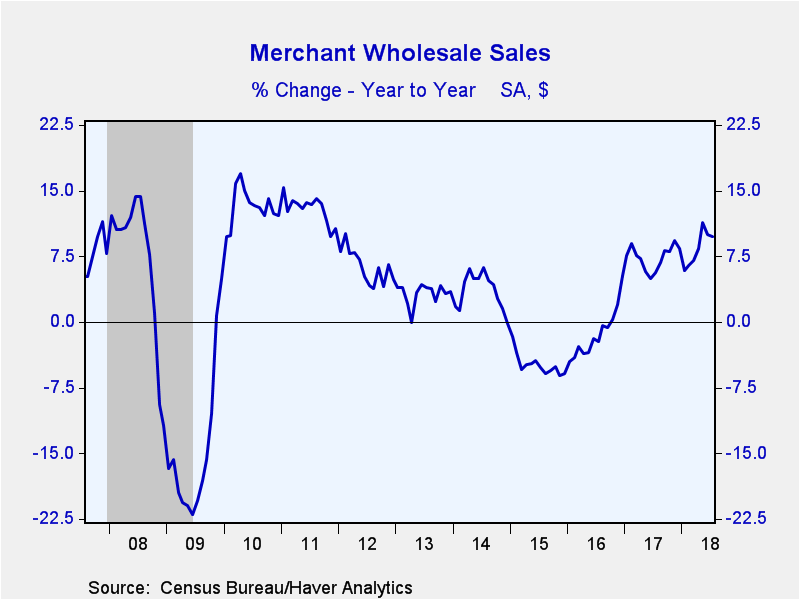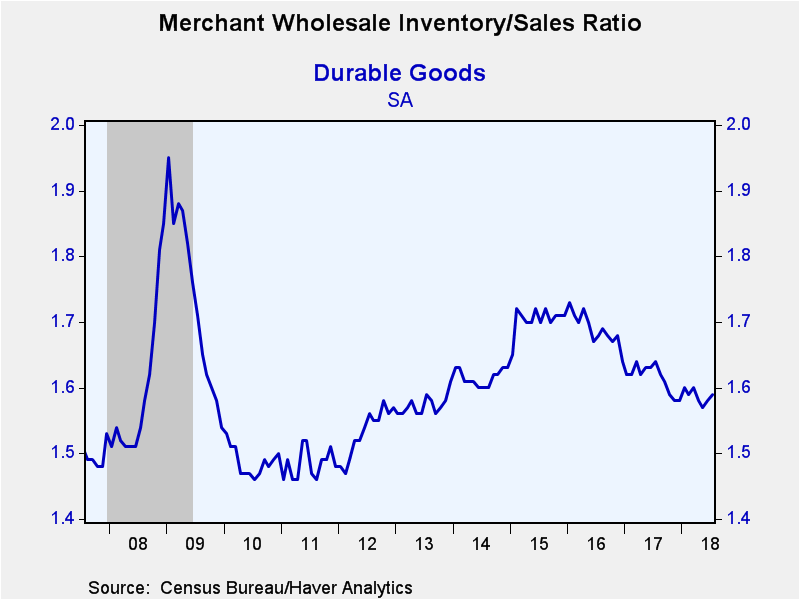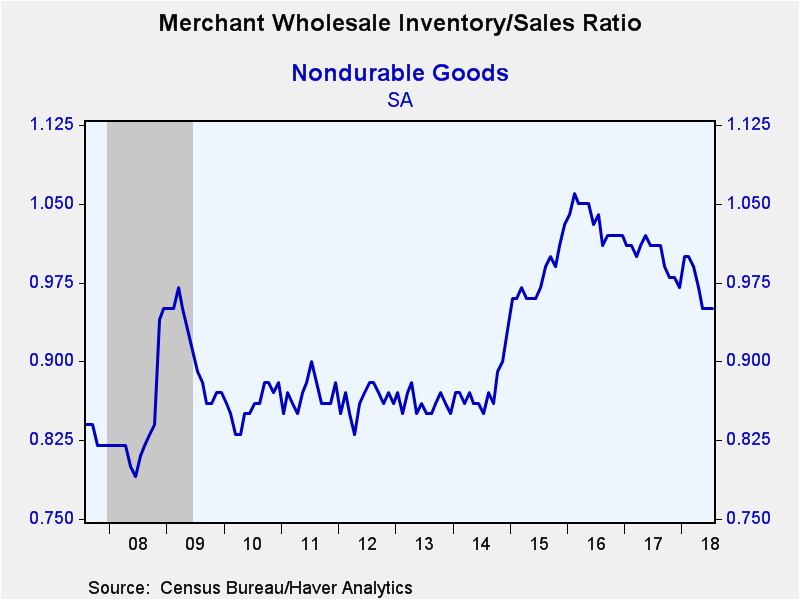 Global| Sep 11 2018
Global| Sep 11 2018Wholesale Inventories Jumped in July While Sales Floundered
by:Sandy Batten
|in:Economy in Brief
Summary
Wholesale inventories jumped 0.6% m/m (5.0% y/y) in July following an unrevised 0.1% m/m increase in June. The July increase is a little smaller than expected--the Informa Global Markets Survey had looked for a 0.7% m/m increase. [...]
Wholesale inventories jumped 0.6% m/m (5.0% y/y) in July following an unrevised 0.1% m/m increase in June. The July increase is a little smaller than expected--the Informa Global Markets Survey had looked for a 0.7% m/m increase. Also, this increase was slightly smaller than the 0.7% m/m rise contained in the advance report released two weeks ago.
The advance in durable goods inventories slowed in July with a 0.8% m/m (6.1% y/y) rise versus a 0.9% m/m increase in June. Automotive (-1.1% m/m) and miscellaneous durable goods inventories (-0.9% m/m) each fell while all other categories experienced monthly increases. Inventories of computing equipment led the July rise with a 3.8% m/m increase with metals inventories posting a robust 3.1% m/m gain. A rebound in nondurable goods inventories led the overall July surge. These inventories rose 0.3% m/m (3.3% y/y) in July after having fallen 1.0% m/m in June. The recovery in nondurable inventories was largely propelled by paper inventories (2.0% m/m) and farm inventories (1.4% m/m).
Wholesale sales were essentially unchanged in July (+9.8% y/y) from June after a downwardly revised 0.2% m/m decline in June (initially reported as a 0.1% m/m fall). The Action Economics Survey had looked for a 0.3% m/m increase.
Sales of durable goods were unchanged in July (+9.6% y/y) versus a 0.2% m/m rise in June. Sales of computing equipment fell 4.0% m/m and sales of furniture slipped 3.2% m/m. Hardware sales posted the largest monthly increase with a 1.7% m/m gain. Sales of nondurable goods declined 0.1% m/m (+10.0% y/y) following a 0.6% m/m slump in June. Apparel sales continued to fall with an outsized 6.4% m/m drop in July.
With inventories rising and sales unchanged, the inventory-to-sales (I/S) ratio at the wholesale level edged up to 1.26 in July from 1.25 in each of the previous two months. This is still the second lowest reading since December 2014.
The I/S ratio for durable goods increased to 1.59 from 1.58, its second consecutive monthly increase while the I/S ratio for nondurables was unchanged at 0.95, its lowest reading since December 2014. With weak furniture sales in July, this sector's I/S ratio jumped to 1.84 from 1.78. Similarly, for apparel: the sharp drop in sales was accompanied by a surge in this sector's I/S ratio to 2.15 from 2.00. And the I/S ratio for petroleum and products continued its general decline, falling to 0.37 in July, its lowest level since November 2014.
The wholesale trade figures are available in Haver's USECON database. The expectations figure for inventories is contained in the MMSAMER database. Expectations for sales are in the AS1REPNA database.
| Wholesale Sector - NAICS Classification (%) | Jul | Jun | May | Y/Y | 2017 | 2016 | 2015 |
|---|---|---|---|---|---|---|---|
| Inventories | 0.6 | 0.1 | 0.3 | 5.0 | 3.6 | 2.2 | 1.3 |
| Sales | 0.0 | -0.2 | 2.1 | 9.8 | 7.4 | -1.3 | -4.9 |
| I/S Ratio | 1.26 | 1.25 | 1.25 | 1.32 (Jul '17) | 1.30 | 1.35 | 1.33 |
Sandy Batten
AuthorMore in Author Profile »Sandy Batten has more than 30 years of experience analyzing industrial economies and financial markets and a wide range of experience across the financial services sector, government, and academia. Before joining Haver Analytics, Sandy was a Vice President and Senior Economist at Citibank; Senior Credit Market Analyst at CDC Investment Management, Managing Director at Bear Stearns, and Executive Director at JPMorgan. In 2008, Sandy was named the most accurate US forecaster by the National Association for Business Economics. He is a member of the New York Forecasters Club, NABE, and the American Economic Association. Prior to his time in the financial services sector, Sandy was a Research Officer at the Federal Reserve Bank of St. Louis, Senior Staff Economist on the President’s Council of Economic Advisors, Deputy Assistant Secretary for Economic Policy at the US Treasury, and Economist at the International Monetary Fund. Sandy has taught economics at St. Louis University, Denison University, and Muskingun College. He has published numerous peer-reviewed articles in a wide range of academic publications. He has a B.A. in economics from the University of Richmond and a M.A. and Ph.D. in economics from The Ohio State University.










